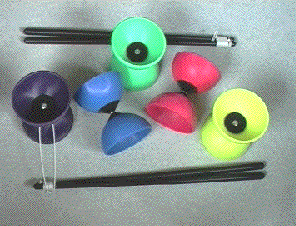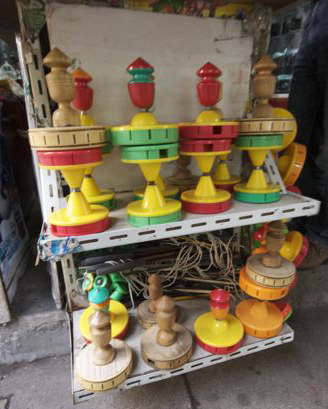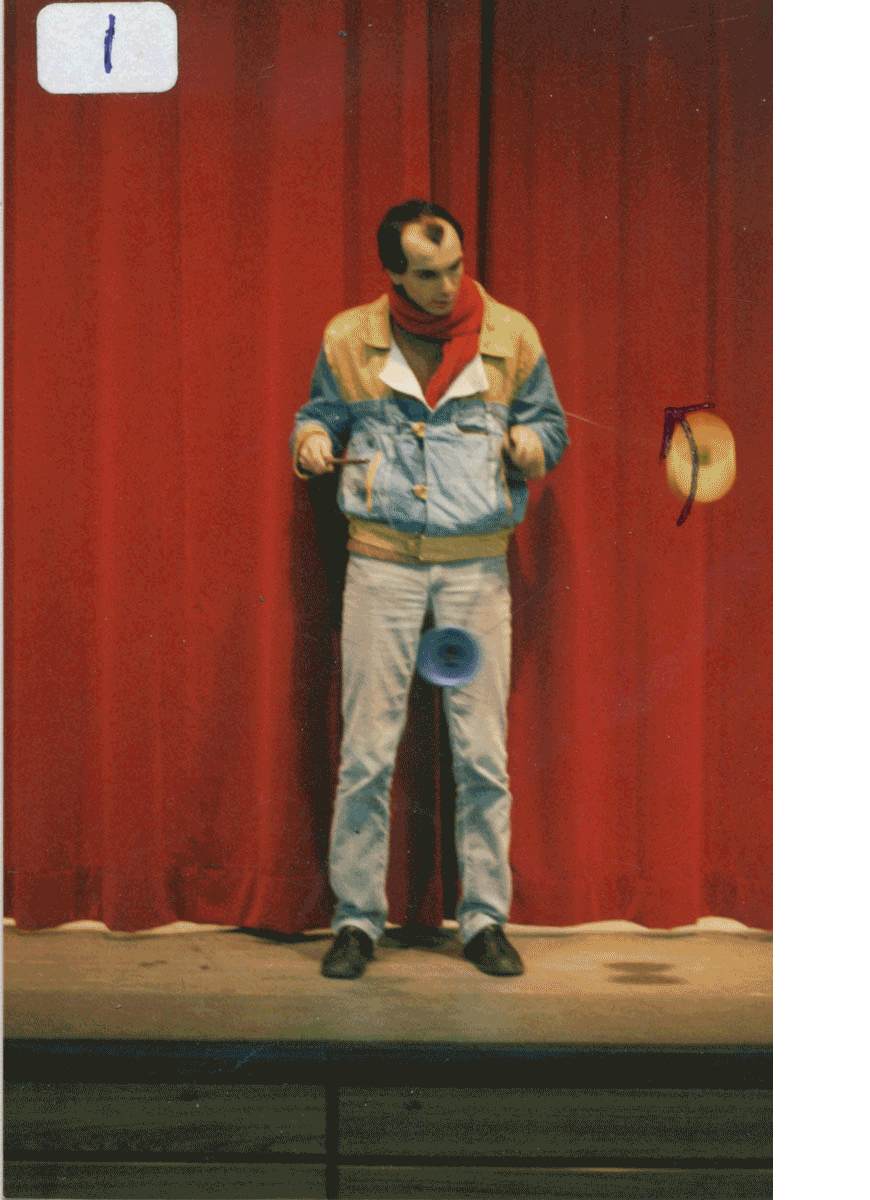Diabolo
Imagine a yo-yo that can fly! That's the fun you can have with a diabolo. This ancient toy originated in China. Recommended for ages eight and up.
The Diabolo Book
Over sixty tricks, fully illustrated, and a great history chapter; folks seem to like it. 85 pages, $14.95
Todd Strong's "The Diabolo Book" should serve as a model for everyone interested in writing a juggling book...Strong's writing style is clear and to the point...
However, the thing that really sets this instruction book apart from others is Strong's extensive essay on the history of the diabolo. Juggler's World
Currently out of stock of The Diabolo Book. Will update this page if new copies come in.

These durable diabolos consist of two rubber cups attached to a metal axle. Diabolos measure fourteen centimeters across with a diameter of eleven centimeters (aprrox. 5 1/2" X 4 3/8" ). Flexible plastic handsticks bend instead of breaking.
Diabolo set, $15.00
Please note: Only have few of the purple sets left in stock. When these are gone, I will no longer be sellling diabolos.
| Ship to: | Shipping charge | |
| U.S.A. |
Total: $19.45 |
Airmail
two to three business days $4.45 |
| Canada |
Total: $21.25 |
Airmail
four to seven business days $6.25 |
| Europe | Shipping this item to Europe is pretty expensive. You'd be better off finding a diabolo locally. | |
| The Rest of the World
Oceania, Asia, Africa, South America |
Shipping this item is pretty expensive. You'd be better off finding a diabolo locally. |

Special Diabolo Deal: Order a diabolo set with The Diabolo Book and get a package price, $22 for both.
Currently out of stock of The Diabolo Book. Will update this page if new copies come in.
|
|
||||
|
|
Page # |
|||
|
Acknowledgments |
vii |
|||
|
Introduction |
1 |
|||
|
Chapter 1: Getting Started |
5 |
|||
|
Diabolo Terms |
6 |
|||
|
Two Methods to Start Spinning the Diabolo |
7 |
|||
|
Starting the Diabolo in the Air |
7 |
|||
|
Starting the Diabolo From the Ground |
8 |
|||
|
The Recovery Stroke |
9 |
|||
|
The Power Stroke |
10 |
|||
|
Variations on Loops of String Around the Axle |
11 |
|||
|
Smooth It Out |
12 |
|||
|
Correcting Tilts and Twists |
12 |
|||
|
The Tilting Diabolo |
12 |
|||
|
The Twisting Diabolo |
14 |
|||
|
The Diabolo Out of Balance |
15 |
|||
|
Chapter 2: Teaching Your Diabolo Some Tricks |
17 |
|||
|
Introduction to the Addvanced Moves |
18 |
|||
|
Throws and Catches |
19 |
|||
|
Jump Rope |
20 |
|||
|
Behind the Back Catch |
20 |
|||
|
Catch on the Handstick |
21 |
|||
|
Catch on the Crossed Handstick |
21 |
|||
|
Bounces |
22 |
|||
|
Continuous Throws |
22 |
|||
|
Roll Alongs |
23 |
|||
|
Snap Backs |
23 |
|||
|
String Around the Neck |
23 |
|||
|
Cat's Cradle |
24 |
|||
|
Cat's Cradle Variation#1 |
25 |
|||
|
Double Cat's Cradle |
26 |
|||
|
Pirouettes |
26 |
|||
|
Around the Back |
27 |
|||
|
Around the Head |
27 |
|||
|
The Whip |
28 |
|||
|
Climbs |
30 |
|||
|
High Climbs |
31 |
|||
|
Cat's Cradle Climb |
32 |
|||
|
String Tricks |
34 |
|||
|
Spaghetti |
34 |
|||
|
Spaghetti Up |
34 |
|||
|
Winding the String |
35 |
|||
|
Around the World |
36 |
|||
|
Half-way Around the World |
37 |
|||
|
Around the World the Scary Way |
38 |
|||
|
Around the Diabolo |
38 |
|||
|
Hop Overs |
39 |
|||
|
Hop Over Thigh |
40 |
|||
|
Hop Over Waist |
40 |
|||
|
Hop Over Both Hips |
41 |
|||
|
Hop Over the Handstick |
41 |
|||
|
Hop Over the Arm |
42 |
|||
|
One Handed |
43 |
|||
|
Around the World Crossovers |
44 |
|||
|
Two Fisted Diabolos |
44 |
|||
|
Other Tricks |
45 |
|||
|
Rock the Baby |
45 |
|||
|
Butterflies |
45 |
|||
|
Loop Arounds |
46 |
|||
|
Dynamic Pirouettes |
48 |
|||
|
One-Wheeled Diabolos |
50 |
|||
|
Spinning Two Diabolos At Once |
52 |
|||
|
Correcting Tilts with Two Diabolos |
55 |
|||
|
Variations with Two Diabolos |
55 |
|||
|
Chapter 3: Diabolo Play With a Partner |
59 |
|||
|
Passing One Diabolo |
60 |
|||
|
Passing Two Diabolos |
62 |
|||
|
Steals |
63 |
|||
|
Pass Alongs |
64 |
|||
|
Diabolo Tennis |
65 |
|||
|
Chapter 4: History of the Diabolo |
67 |
|||
|
Afterword |
81 |
|||
Review originally appeared in the Spring 1995 issue of Juggler's World magazine. Reprinted with permission of the publisher.
Todd Strong's "The Diabolo Book" should serve as a model for everyone interested in writing a juggling book. The author combines a large helping of instructional material with a rich portion of prop history, and leavens the mix with just a tiny bit of psychology and philosophy.
It's overwhelmingly just the facts - the facts of how to learn diabolo manipulation from ground zero to complex tricks, and the fascinating facts of its fairly well documented history.
Strong's writing style is clear and to the point, splashed with enough appropriate humor and author's personal comments to give the book personality. Good writing rises or falls on the artwork that supports it, and this books stands tall because of its attractive line drawings, photos of contemporary artists doing diabolo, reproductions of turn-of-the-century diabolo post cards and four-color soft cover. The clean layout and ample illustrations make it fun to keep turning through its 90 pages.
The heart of the book, as the author states, is the "tricks" section. He presents about 45 tricks in the order that most people learn them, beginning with throws and catches and advancing all the way to two diabolos. Dozens of simple, realistic pen and ink drawings of the author performing the trick, or closeups of the stick and string arrangement, clarify the associated text.
A subsequent short section describes passing, steals and pass-alongs with a partner.
However, the thing that really sets this instruction book apart from others is Strong's extensive essay on the history of the diabolo. The author takes appropriate credit for helping popularize the diabolo with this generation of jugglers, but from the beginning of his involvement with the diabolo in 1980 it has been for him a scholarly pursuit as well as a physical one. The book originally began as Strong's master's thesis, and he lists more than a dozen libraries at which he conducted research during the course of its writing. His teaching credits include appointments at Die Etage school in Berlin and at the Centre National des Arts du Cirque in France. The weight of this academic research and Strong's years of experience as a teacher give the book an authority not found in most juggling books.
Though no skill or prop can be traced to an absolute beginning, Strong makes a good case for the origin of the diabolo in ancient China. His research uncovered interesting stories of its appearance in Europe in about 1790, brought back from the Orient by statesmen and traders. He digresses at that point into a discussion of the "diabolo" that should establish once and for all how the name came to be.
The history of the prop continues through its use as a rich person's toy in the early 1800s, then as a national passion in France in the early 1900s, complete with local clubs, tournaments and a team lawn game similar to tennis.
The diabolo's third Western renaissance has been spurred in the past decade by jugglers adding it to the inventory of their manipulative skills. The appearance of Strong's comprehensive and attractive book puts the art on a high pedestal this time around!
The following review originally appeared in the Winter 1994 issue of Kaskade, the European Juggling Magazine. Reprinted with permission of the author, Wolfgang Schebeczek, and the publisher.
The Diabolo Book
The Ultimate Step-by-step Guide to Mastering the Diabolo. Todd Strong, Brian Dubé, Inc., New York 1994, 85 pages, $14.95 ISBN 0-917643-10-0
It's taken two years for the English edition of Todd Strong's Diabolo - Spielend lernen to appear. But here it is at last, and despite the not entirely original title (see Jack Wiley's book on the same subject), it has been worth waiting for: the original book has been reworked and expanded. On the tricks and techniques, you can read all you need to know in the review of the German version (Kaskade No. 26, p. 35), because little has changed since then, content-wise. But a number of anomalies have been cleared up in the historical section. In particular, the references to other literature, which caused me problems in the past, have been licked into shape and are now useable. The most mentionable aspect of the English edition, though, are the new visuals. The historical photos documenting the diabolo boom around the turn of the century are especially interesting. Many of the pictures are taken from Todd Strong's private collection of vintage postcards.
The world of diabolo has moved on since the German edition first appeared. But to my mind, Todd Strong's book is still the best introduction for newcomers. Only Ralf Runde's Das grosse Diabolobuch comes close to it. And nothing compares with Todd Strong's survey of diabolo history. Which is one of the reasons why I predict that this book is destined to become a classic. If you're undecided about whether to choose the English or the German version, I suggest you get The Diabolo Book.
(the same review in German, auf Deutsch)
The Diabolo Book
Mehr als zwei Jahre hat die englische Ausgabe von Todd Strongs Diabolo - Spielend lernen auf sich warten lassen. Nun liegt sie unter dem nicht ganz originellen Titel (Jack Wileys Diabolobuch heißt auch so) The Diabolo Book vor. Das Warten hat sich aber gelohnt, da das Buch überarbeitet und ergänzt wurde. Zum Trick- und Technikteil findest du Wissenswertes in der Besprechung der deutschen Version (Kaskade Nr. 26, S 35), hier hat sich inhaltlich nicht viel verändert. Im historischen Teil sind einige Ungereimtheiten beseitigt worden. Insbesondere sind die Literaturhinweise, die mir manche Rätsel aufgegeben haben, nun brauchbar. Vor allem aber muß das neue Bildmaterial erwähnt werden. Besonders interessant: die historischen Fotos vom Diaboloboom um die Jahrhundertwende; vieles davon stammt aus Todd Strongs privater Sammlung antiker Postkarten.
Seit Erscheinen der deutschen Ausgabe hat sich einiges am Diabolobuchsektor getan. Aber meiner Meinung nach vermittelt Todd Strongs Buch Neulingen immer noch den besten Einstieg, höchstens Ralf Rundes Das große Diabolobuch kann sich da noch messen. Die kritische Aufarbeitung der Geschichte des Diabolospiels ist überhaupt einzigartig. Nicht zuletzt deswegen würde ich dem Buch prophezeien, ein Klassiker zu werden. Wer vor der Entscheidung steht, deutsche oder englische Ausgabe, soll sich besser gleich The Diabolo Book besorgen.
Wolfgang Schebeczek, Vienna, Austria
This short clip is an extract from Abel Gance's 1927 film, Napoléon. This scene shows Josephine's two children, Eugène and Hortense, waiting to meet Napoléon for the first time. Eugène is seen spinning a diabolo. The film appears to be historically accurate, as diabolos were a popular pastime during the time depicted in the movie.

Photo taken by David Aiken, The Checkerboard Guy, in of a street scene in Nanjing, China.

Above is a GIF animation of what may be the first recorded variation with two diabolos.
In 1986 or '87 Michael Genahr mailed me a series of photographs showing him demonstrating a reverse in the normal shower of two diabolos. He hand numbered the photos, drew in some arrows to show directions, and wrote a brief description of what he was doing on some of the images.
The descritptions are:
Image 5: the yellow goes under the blue almost by itself. The blue "jumps"
Image 6: to the left string and the "turning direction" (?)
Image 7: changes! This is the very moment were both D's stand still.
Image 8: to throw the blue without hitting the yellow is somewhat difficult

- Home
- About
- Ball Juggling
- Cigar Boxes
- Club Juggling
- Club Swinging
- Comedy Writing
- Cup Stacking
- Devil Sticks
- Diabolo
- Diabolo Postcards
- Dice Stacking
- Hat Manipulation
- Lasso
- Miscellanous Juggling
- Parachute Games
- Poi Swinging
- Ring Juggling
- Shaker Cups
- Skill Games
- Staff
- Tennis Balls and Can
- New Games Foundation
- Ordering and Shipping
- Contact Information
- Peeps (photos of birds and stuff)
- Personal Thoughts
- Workshops
- Links
- Questions? Comments? Feedback?